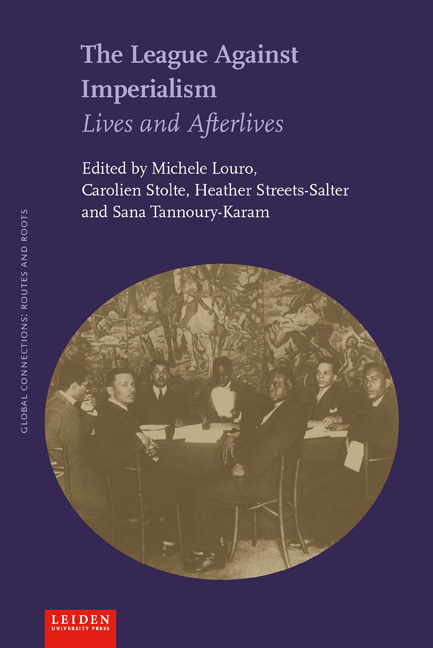Book contents
- Frontmatter
- Dedication
- Contents
- List of Illustrations
- Foreword: Plotting the Anti-Colonial Transnational
- 1 The League Against Imperialism: Lives and Afterlives
- 2 Forging a Proto-Third World? Latin America and the League Against Imperialism
- 3 An Independent Path: Algerian Nationalists and the League Against Imperialism
- 4 “Long Live the Revolutionary Alliance Against Imperialism”: Interwar Anti-Imperialism and the Arab Levant
- 5 China, Anti-imperialist Leagues, and the Comintern: Visions, Networks and Cadres
- 6 “We will fight with our lives for the equal rights of all peoples”: Willi Münzenberg, the League Against Imperialism, and the Comintern
- 7 British Passport Restrictions, the League Against Imperialism, and the Problem of Liberal Democracy
- 8 No More Slaves! Lamine Senghor, Black Internationalism and the League Against Imperialism
- 9 Unfreedom and Its Opposite: Towards an Intellectual History of the League Against Imperialism
- 10 An Anti-Imperialist “Echo” in India
- 11 Two Leagues, One Front? The India League and the League Against Imperialism in the British Left, 1927–1937
- 12 Herald of a Failed Revolt: Mohammad Hatta in Brussels, 1927
- 13 The Leninist Moment in South Africa
- 14 Towards Afro-Asia? Continuities and Change in Indian Anti-Imperialist Regionalism, 1927–1957
- 15 Institutionalizing Postcolonial Internationalism: The Apparatus of the Third World Project
- Afterword: the Zigzag of the Global in the Histories of the League Against Imperialism
- Index
12 - Herald of a Failed Revolt: Mohammad Hatta in Brussels, 1927
Published online by Cambridge University Press: 04 January 2025
- Frontmatter
- Dedication
- Contents
- List of Illustrations
- Foreword: Plotting the Anti-Colonial Transnational
- 1 The League Against Imperialism: Lives and Afterlives
- 2 Forging a Proto-Third World? Latin America and the League Against Imperialism
- 3 An Independent Path: Algerian Nationalists and the League Against Imperialism
- 4 “Long Live the Revolutionary Alliance Against Imperialism”: Interwar Anti-Imperialism and the Arab Levant
- 5 China, Anti-imperialist Leagues, and the Comintern: Visions, Networks and Cadres
- 6 “We will fight with our lives for the equal rights of all peoples”: Willi Münzenberg, the League Against Imperialism, and the Comintern
- 7 British Passport Restrictions, the League Against Imperialism, and the Problem of Liberal Democracy
- 8 No More Slaves! Lamine Senghor, Black Internationalism and the League Against Imperialism
- 9 Unfreedom and Its Opposite: Towards an Intellectual History of the League Against Imperialism
- 10 An Anti-Imperialist “Echo” in India
- 11 Two Leagues, One Front? The India League and the League Against Imperialism in the British Left, 1927–1937
- 12 Herald of a Failed Revolt: Mohammad Hatta in Brussels, 1927
- 13 The Leninist Moment in South Africa
- 14 Towards Afro-Asia? Continuities and Change in Indian Anti-Imperialist Regionalism, 1927–1957
- 15 Institutionalizing Postcolonial Internationalism: The Apparatus of the Third World Project
- Afterword: the Zigzag of the Global in the Histories of the League Against Imperialism
- Index
Summary
In Flammenzeichen vom Palais Egmont, the published proceedings of the first Congress in Brussels, there is a picture of Mohammad Hatta, the future first vice president of Indonesia. It shows a crowded conference table in one of the side meetings of the Congress. Among the discussants are Jawaharlal Nehru of the Indian National Congress, Willi Munzenberg, chairman of the Internationale Arbeiterhilfe (International Workers’ Relief), and Liao Huanxing of the Chinese Guomindang Party. Hatta— still without his iconic round glasses—is chairing this meeting and, seen from the back, he turns around to look into the camera.
The picture suggests that Mohammad Hatta was a prominent participant of the Congress, and as such he is remembered. On the last day Hatta was elected to the newly established executive committee of the LAI. In this executive committee, which came together on a regular basis between 1927 and 1929, Hatta acquired a large network of influential and experienced political leaders and activists, such as Nehru, Munzenberg, and Liao Huanxing. This enhanced his prestige in the Netherlands and in the Indonesian national movement.
Yet, in 1927 Hatta was a young man of 25 years old with very little international political experience. He was chairman of a very small organization for Indonesian students in the Netherlands, the Perhimpoenan Indonesia (Indonesian Association, PI), which numbered around twenty active members at the end of the 1920s. Nehru, by contrast, was already a renowned person in the Indian Congress Party, representing millions of Indians. Who was this young Hatta in 1927, and how can we explain his prominent position in the LAI?
In Indonesian political historiography and literature on interwar internationalism Hatta's position in the LAI is ill understood. Indonesianists take the Indonesian involvement in Brussels as evidence for the rising influence of Hatta and his fellow students as political leaders, and as the result of continuous efforts to bring the situation in his fatherland to the attention of foreign audiences. This approach does not make clear why the organizers of the LAI were interested in offering this tiny Dutch student organization a platform and a seat in the executive committee.
- Type
- Chapter
- Information
- The League Against ImperialismLives and Afterlives, pp. 309 - 324Publisher: Amsterdam University PressPrint publication year: 2020

